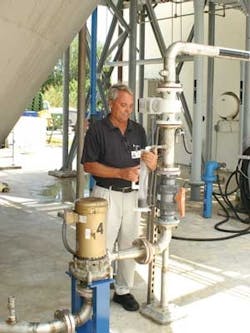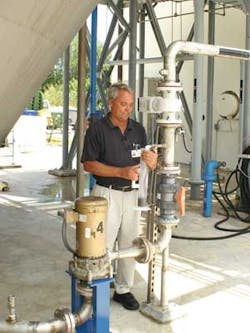Officials conduct inspection of Barrier Island Berms
BATON ROUGE, LA, Oct. 4, 2010 -- State Coastal Protection and Restoration Authority officials conducted an inspection trip of the barrier island berms today to review construction operations. David Cresson, Executive Director of the Coastal Conservation Association of Louisiana, joined state officials on the trip. The flyover included a review of construction operations on the northern Chandeleur berm, known as E-4, and berms on the west side of the river in the vicinity of the Pelican and Scofield barrier islands.
To date, over 350 million cubic feet of sand, or the equivalent of digging up 665 miles of four-lane interstate has been dredged to construct the berms. Including berm construction on East Grand Terre, the total miles of berm constructed along the alignment of our historical barrier islands is approaching 10 miles. "This project went from an idea to construction in about five weeks. A project of this size, scope and complexity with such intense resources is unprecedented in our coastal area.," noted Garret Graves, Chairman of the Coastal Protection and Restoration Authority.
The barrier island berms serve as an effective oil protection structure. With the loss of over 2300 square miles of coastal wetlands in Louisiana, the state's coast consists of a fragmented, porous shoreline totaling nearly 8000 miles long. This compares to 359 miles in Mississippi and 607 miles in Alabama.
Cresson noted,"You just cannot understand this project unless you have the opportunity to see it.The shear size of the berms and progress that has been made is amazing. CCA strongly supports Governor Jindal and CPRA's efforts on the berm project. This project plays an important role in protecting Louisiana's marshes and coastal fishery."
After a short walk on the Chandeleur berms, state officials found tar balls on the water's edge.
"This is why the berms make sense. The amount of confirmed oil in the gulf today is multiple times more than was estimated when the berms were first conceived or approved. We have two choices, we can try to clean the oil out of our marshes for decades to come or we can stop the surface and submerged oil miles away and prevent it from ever getting to the marsh," Graves said.
Scientist estimates indicate that millions of barrels of oil remain in the Gulf. Last month, researchers located a two inch layer of oil in the Gulf of Mexico.
###

